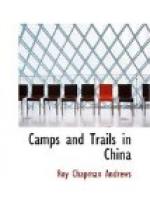The Chinese are at once the most practical and the most sentimental of the human race. New Year must not be violated by duns for debts, and the debts must be collected New Year though it be. For this reason one sometimes sees an urgent creditor going about early on the first day of the year carrying a lantern looking for his creditor [=debtor]. His artificial light shows that by a social fiction the sun has not yet risen, it is still yesterday and the debt can still be claimed....
We have but to imagine the application of the principles which we have named, to the whole Chinese Empire, and we get new light upon the nature of the Chinese New Year festivities. They are a time of rejoicing, but there is no rejoicing so keen as that of a ruined debtor, who has succeeded by shrewd devices in avoiding the most relentless of his creditors and has thus postponed his ruin for at least another twelve months.
For, once past the narrow strait at the end of the year, the debtor finds himself again in the broad and peaceful waters, where he cannot be molested. Even should his creditors meet him on New Year’s day, there could be no possibility of mentioning the fact of the previous day’s disgraceful flight and concealment, or indeed of alluding to business at all, for this would not be “good form” and to the Chinese “Good Form” (otherwise known as custom), is the chief national divinity. [Footnote: “Village Life in China,” by Arthur H. Smith, 1907, pp. 208-209.]
Yung-chang appears to be almost entirely inhabited by Chinese and in no part of the province did we see foot-binding more in evidence. Practically every woman and girl, young or old, regardless of her station in life was crippled in this brutal way. The women wear long full coats with flaring skirts which hang straight from their shoulders to their knees. When the trousers are tightly wrapped about their shrunken ankles, they look in a side view exactly like huge umbrellas.
One day we visited a cave thirty li north of the city where we hoped to find new bats. A beautiful little temple has been built over the entrance to the cavern which does not extend more than forty or fifty feet into the rock. But twenty li south of Yung-chang, just beyond the village of A-shih-wo, there is an enormous cave which is reported to extend entirely through the hill. Whether or not this is true we can not say for although we explored it in part we did not reach the end. The central corridor is about thirty feet wide and at least sixty or seventy high. We followed the main gallery for a long distance, and turned back at a branch which led off at a sharp angle. We were not equipped with sufficient candles to pursue the exploration more extensively and did not have time to visit it again. The cave contained some beautiful stalactites of considerable size, but the limestone was a dull lead color. We found only one bat and these animals appear not to have used it extensively since there was little sign upon the floor.




